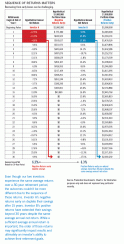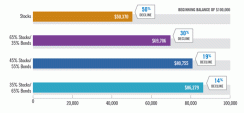Let’s say an investor has done everything right in the 20 to 30 years leading up to her retirement; she’s worked hard and saved enough to retire in the next few years. What could possibly go wrong? Simply stated: bad luck—in the form of a major market drop just as she’s about to retire.
“Suffering an extreme market event when on the verge of retirement can derail peoples’ ability to retire, or dramatically alter what their life will be like once in retirement,” says Michael Rosenberg, head of IODC Distribution at Prudential Investments. “Just a few years of negative returns right before or after a person starts taking distributions can quickly erode decades of retirement savings, often to the point of being unable to generate enough income to last a lifetime.”
THE RETIREMENT RED ZONE
A study conducted by the PEW Research Center shortly after the 2008 financial crisis found over one-third of adults 62 and older delayed retirement because of the recession. Prudential has pioneered the concept of the Retirement Red Zone® to potentially protect investors during the most critical years prior to and just after retirement. Poor investment performance during this time can have a lasting effect on a portfolio, often leaving little time to recover. The result can be a retirement
that runs out of money.
HOW SEQUENCE RISK CAN UNDO YEARS OF PLANNING
For young people just beginning to save for retirement, the biggest risk is underinvesting in more aggressive assets such as equities. But the greatest risk for those nearing retirement is an overly aggressive allocation with an abundance of equity in their portfolio. Doing so exposes them to what is known as sequence of returns risk. A few years of below-average returns right before or after an investor begins to take distributions in retirement can quickly erode their retirement savings to the point that they’ll be unable to generate enough income to last a lifetime.
The example below shows how losses early in retirement can undermine a person’s retirement strategy.
Each investor starts with $1,000,000 in savings and withdraws $50,000 a year adjusted for 3% inflation. Both portfolios result in a 6.3% average return and assume the same return series with the order of returns reversed in Investor B’s portfolio

Even though our two investors experience the same average returns over a 30-year retirement period, the outcomes couldn’t be more different due to the sequence of those returns. Investor A’s negative returns early on deplete their savings after 15 years. Investor B’s positive returns have extended their savings beyond 30 years despite the same average annual net return. While a sufficient average annual return is important, the order of those returns may significantly impact results and ultimately an investor’s ability to achieve their retirement goals
AVOIDING SEQUENCE OF RETURNS RISK
One of the best ways to protect wealth as retirement draws closer is to begin to “de-risk” the portfolio. “We believe that drastically reducing equity exposure and allocating more to fixed income during the 10 years before and after retirement, which we call the ‘Retirement Red Zone,’ can result in better outcomes,” says Jeremy Stempien, product specialist on QMA’s asset allocation team. “Bonds are much less volatile than stocks and, in fact, they have not had a decline of 10% or more in a calendar year since 1926. Stocks have experienced declines of that magnitude about once every eight years.”
Using bonds as a de-risking strategy during the 2008–2009 stock market correction would have preserved a significant percentage of wealth for those in or approaching retirement. Mr. Stempien stresses that de-risking does not mean removing all risk from the portfolio, because equity still plays an important role during retirement.

Source: Morningstar. Stocks are represented by the S&P 500 Index. Bonds are represented by the Barclays U.S. Aggregate Bond Index. Calculated by Prudential Investments LLC using data from Morningstar. All rights reserved. Used with permission. Indexes and category averages are unmanaged and do not take into account fees and expenses. You cannot invest directly in an index or category average.
IMPACT OF MARKET CORRECTION* ON ACCOUNT VALUES
“We suggest that retirees gradually reduce equity holdings down to around 45% at retirement and then to about 35% 10 years into retirement,” he says. “You still need the growth potential of stocks and other types of inflation-fighting investments to help fund a retirement that could last 30 years or more.”
INDEX DEFINITIONS
S&P 500® Index is an unmanaged index that includes 500 leading companies in the leading industries of the U.S. economy, capturing 75% coverage of U.S. equities.
Barclays U.S. Aggregate Bond Index represents securities that are SEC-registered, taxable, and dollar-denominated. The index covers the U.S. investment-grade fixed rate bond market, with index components for government and corporate securities, mortgage pass-through securities, and asset-backed securities.
RISKS
Investing involves risk. Some investments are riskier than others. The investment return and principal value will fluctuate, and shares, when sold, may be worth more or less than the original cost, and it is possible to lose money. Past performance does not guarantee future results. Asset allocation and diversification do not assure a profit or protect against loss in declining markets.
The target date is the approximate date when investors plan to retire and may begin withdrawing their money. The asset allocation of the target date funds will become more conservative as the target date approaches by lessening the equity exposure and increasing the exposure in fixed income type investments. The principal value of an investment in a target date fund is not guaranteed at any time, including the target date. There is no guarantee that the fund will provide adequate retirement income. A target date fund should not be selected based solely on age or retirement date. Participants should carefully consider the investment objectives, risks, charges, and expenses of any fund before investing. Funds are not guaranteed investments, and the stated asset allocation may be subject to change. It is possible to lose money by investing in securities, including losses near and following retirement.
1 Source: “How the Great Recession Has Changed Life in America,” PEW Research Center, June 2010.
*November 2007 through February 2009.





